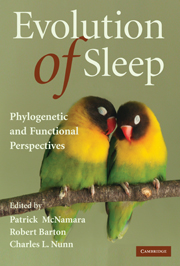Book contents
- Frontmatter
- Contents
- Contributors
- Acknowledgments
- Introduction
- 1 Ecological constraints on mammalian sleep architecture
- 2 Sleep in insects
- 3 Schooling by continuously active fishes: Clues to sleep's ultimate function
- 4 What exactly is it that sleeps? The evolution, regulation, and organization of an emergent network property
- 5 Evolutionary medicine of sleep disorders: Toward a science of sleep duration
- 6 Primate sleep in phylogenetic perspective
- 7 A bird's-eye view of the function of sleep
- 8 The evolution of wakefulness: From reptiles to mammals
- 9 The evolution of REM sleep
- 10 Toward an understanding of the function of sleep: New insights from mouse genetics
- 11 Fishing for sleep
- Index
- Plate section
- References
3 - Schooling by continuously active fishes: Clues to sleep's ultimate function
Published online by Cambridge University Press: 10 March 2010
- Frontmatter
- Contents
- Contributors
- Acknowledgments
- Introduction
- 1 Ecological constraints on mammalian sleep architecture
- 2 Sleep in insects
- 3 Schooling by continuously active fishes: Clues to sleep's ultimate function
- 4 What exactly is it that sleeps? The evolution, regulation, and organization of an emergent network property
- 5 Evolutionary medicine of sleep disorders: Toward a science of sleep duration
- 6 Primate sleep in phylogenetic perspective
- 7 A bird's-eye view of the function of sleep
- 8 The evolution of wakefulness: From reptiles to mammals
- 9 The evolution of REM sleep
- 10 Toward an understanding of the function of sleep: New insights from mouse genetics
- 11 Fishing for sleep
- Index
- Plate section
- References
Summary
Introduction
Aquatic habitats were the cradle of sleep many million years before sleep evolved in terrestrial animals. Yet these habitats were the last to be explored in seeking sleep's ultimate function, which I have suggested to be the enabling of highly efficient brain operation at all times. Although the sleep of most fishes is essentially indistinguishable from that of terrestrial vertebrates, by exploiting the rich variety and greater permissiveness of aquatic habitats, some fishes have bypassed a need for sleep. In three continuously active states, they purportedly achieve comparable, and even greater, benefits than is provided by sleep, yet remain perpetually vigilant.
I propose that “schooling” (swimming synchronously in polarized groups) by these fishes plays a major role in the lack of a need for sleep. Thus, by schooling, they are able to achieve sleep's benefits without closing or occluding their eyes, namely, a great reduction in the average school member's reception and processing of external sensory input. Because the evident benefits of schooling by some fishes substitute for the obscure benefits of sleep by closely related fishes, the evident benefits give clues to the obscure ones. These clues support views on the ultimate function of sleep.
After reviewing circumstances relating to the evolution of sleep in terrestrial animals, relevant topics in the lives of fishes are treated, emphasizing their sleep and its awake, almost equivalent functions with eyes open.
- Type
- Chapter
- Information
- Evolution of SleepPhylogenetic and Functional Perspectives, pp. 57 - 85Publisher: Cambridge University PressPrint publication year: 2009



